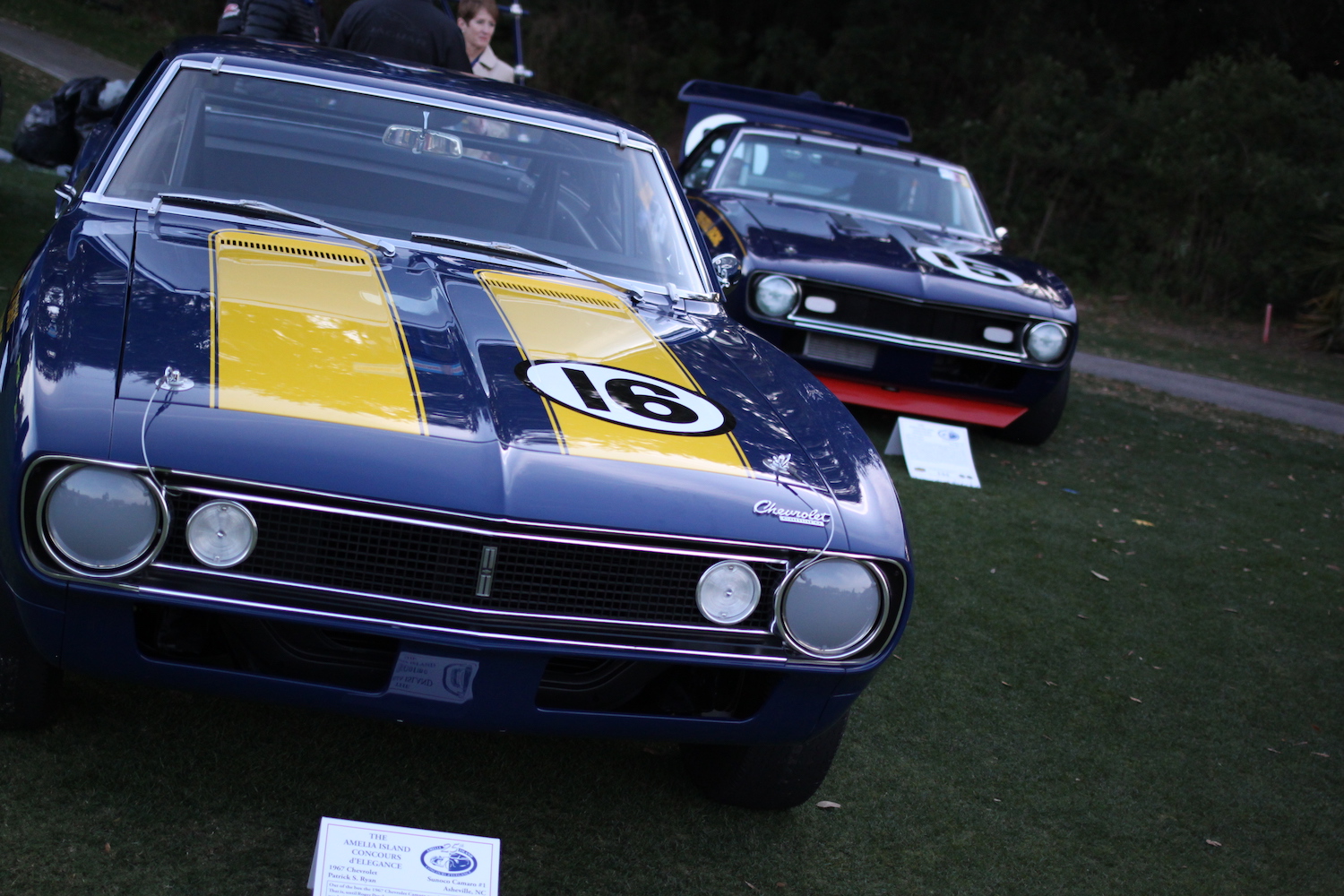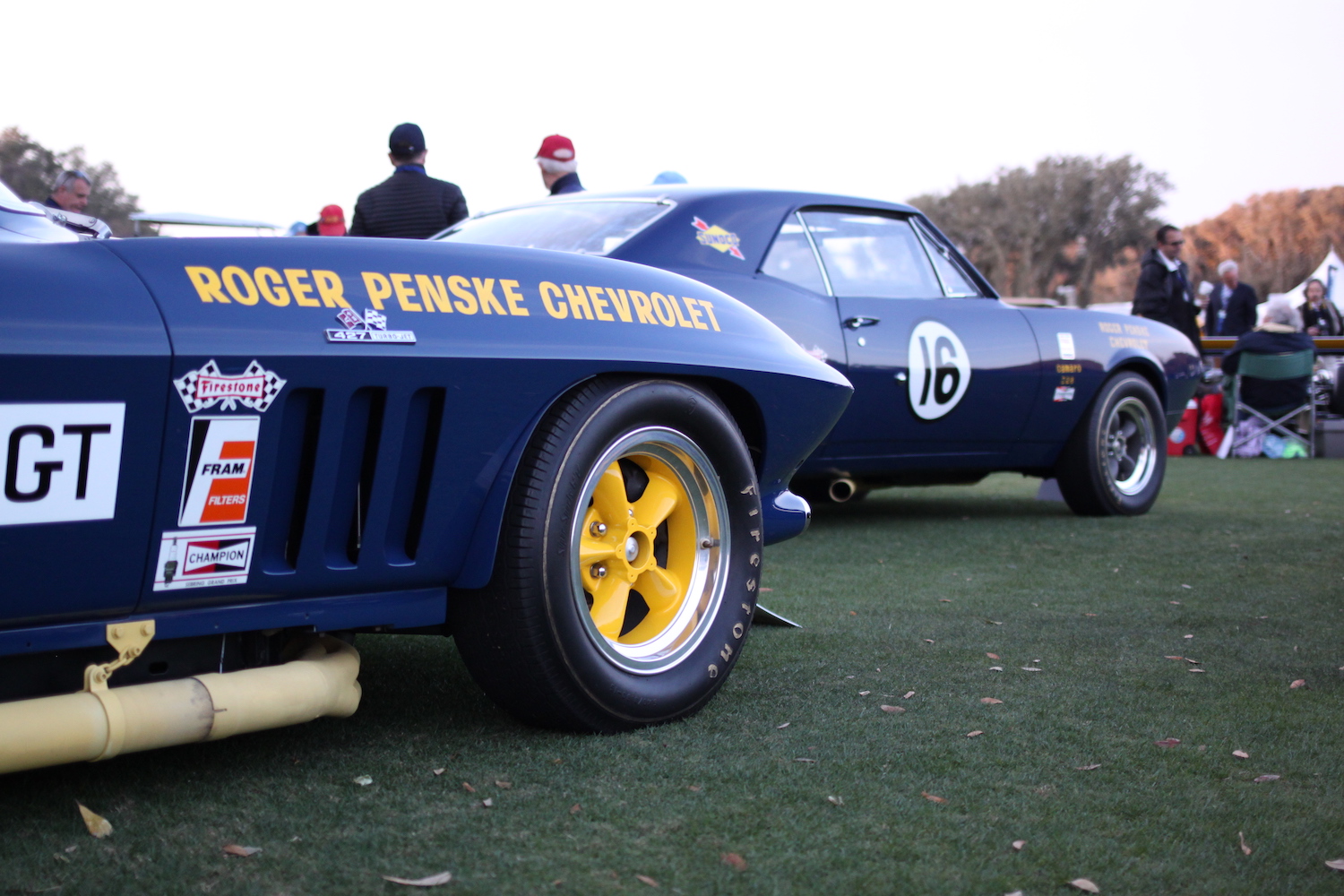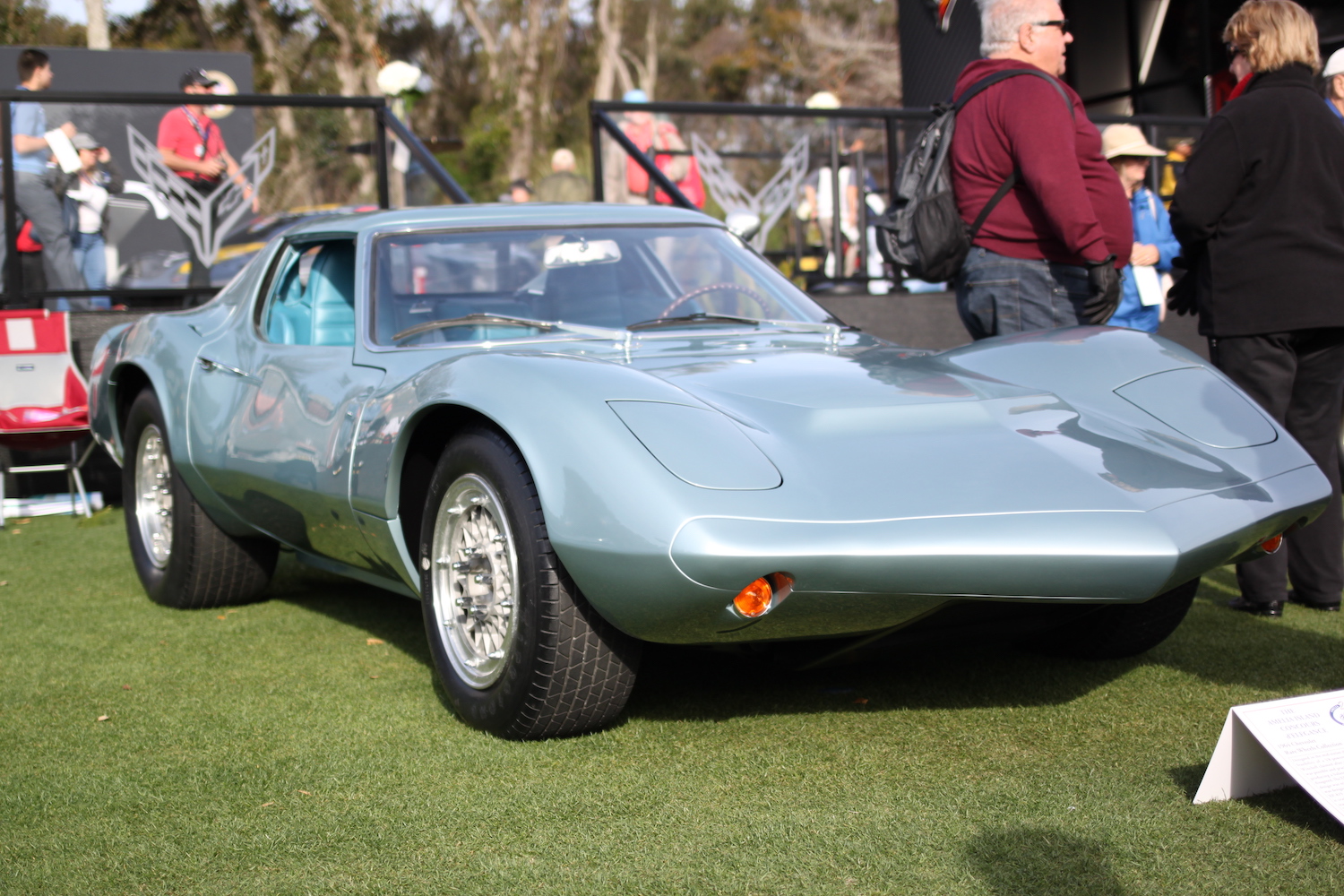Media | Articles
Restoring Team Penske history, one race car at a time
More than 30 historic Team Penske race cars were gathered at the 25th annual Amelia Island Concours d’ Elegance earlier this month to celebrate the life and career of racer and entrepreneur Roger Penske, the event’s honoree.
Team Penske, founded in 1966 with six employees, a dog and an L88 Corvette, became the most winning team in all of motorsport. In fact, with 37 national championships across the racing spectrum, Team Penske is the winningest team in all of professional sports. (Fun fact: The New York Yankees, with 27 World Series titles, are #2.) Today, Penske Corporation employees more than 64,000 worldwide, and the racing team continues to rack up wins and championships.
If the historic Penske cars shown at Amelia Island could talk, they’d tell hair-raising stories of intense competition, a passion for winning and a stream of “unfair advantage” innovations. Kevin Mackay, knows some of those stories well. After all, he’s exhaustively researched Penske cars restored by shop, Corvette Repair in Valley Stream, New York.
Mackay’s team recently added two Penske Trans Am Camaros, along with the first Team Penske racer, an L88 Corvette development car, to their long roster of award-winning restorations. Mackay owns the L88, while the Camaros are owned by his customers.
Another historic Chevrolet restored by Mackay’s team, the 1964 Chevrolet Engineering XP-819, also made its debut at Amelia Island. The rear-engine V-8 experimental sports car was one of a few studies considered as possible extensions of the Corvette line.
Marketplace
Buy and sell classics with confidence
Here’s a closer look at the four:
1966 Chevrolet Corvette L88
20200323135443)
Owner: Kevin J. Mackay
Amelia Award – Team Penske Sunoco
After retiring as a driver in 1965, Roger Penske focused on running his Chevrolet dealership (the start of his business empire) and also launched a racing team from a small, three-bay shop in Newtown Square, Pennsylvania. The first team racer was this 1966 L88 Corvette development car.
In January 1966, Dick Guldstrand piloted the Corvette from the St. Louis factory to Penske’s shop, wrapping himself in a furniture blanket to keep warm in the unheated car. There, the car was race-prepped, including swapping in a special version of the 427 sent by Zora Arkus-Duntov at Chevrolet. This was an early version of what would be offered as RPO L88 in the 1967 Corvette.
The following month, Guldstrand shared driving with George Wintersteen and Ben Moore to take the pivotal Corvette to 12th place overall and first in the GT over-3.0-liter class at the inaugural 24 Hours of Daytona. This remarkable victory for the Corvette was nearly derailed by a crash that took out its headlights. Penske was told the car could not continue, because the rules demanded “forward facing white lights.” The rules did not specify exactly what type of light was required, so Penske’s crew duct-taped flashlights to the fender tops. After arguing with track marshals that these met the standard for “forward facing white lights,” Penske sent Guldstrand back out.

“He followed one of the Ferrari prototype’s taillights, broke the track record for the class and won the class,” says Mackay.
The Penske Corvette was the first production car to cross the finish line, behind the Ford GT40 Mk IIs that swept the podium and a brace of Ferrari and Porsche prototypes. The second-place car in the GT over-3.0-liter class, a Shelby GT350, was 48 laps behind the Corvette.
The following month, the Penske L88 Vette won the GT over-5-liter class and took ninth overall at the Sebring 12 Hours. The car’s Sunoco sponsorship, with the distinctive blue and yellow livery, would soon adorn a long line of Team Penske cars across the racing spectrum.
Mackay spotted this historic Corvette at a car show in the mid-1980s. The owner knew it was the Penske car, but he had begun to return the car to stock street trim. The car had been repainted Nassau Blue (a correct Corvette color), not Sunoco Blue, and was rolling on IROC Camaro wheels.
The L88 still had its racing equipment, including the plastic headlight covers, the original Chevrolet Engineering cowl induction hood, gas cap and reinforcement tabs on the windshield and rear window. Even the original door lights, which illuminate the car’s number for night racing, were still attached. The interior was as Penske had raced it, with its original dash, gauges, toggle switches and door panels.
“I followed the car for a long time and was finally able to buy it in 2001,” says Mackay.
His team started the restoration in September 2001 and finished 11 months later, in time to debut the car at the Concours d’Elegance of America at Meadowbrook in Michigan.
1967 Chevrolet Camaro Trans Am Racer

Owner: Patrick S. Ryan
Amelia Award – Team Penske Sunoco
The SCCA’s Trans-American Sedan Championship, best known as simply “the Trans-Am,” began in 1966 as a venue for compact American and imported “sedans,” though this really meant coupes. Ford won the first year’s championship in the over-2.0-liter class with the Mustang and repeated the feat for the 1967 season. Chevy got in the mix that year, and Team Penske’s Sunoco-sponsored Camaros won three of the 12 races with Mark Donohue driving. Owner Pat Ryan already owned the second of the two 1967 Penske Camaros and years later located the first one in Austria, after searching on-and-off for 25 years.
“It was pretty beat up, but it was all there,” says Mackay, whose shop recently spent seven months restoring the historic racecar.
Before Mackay got it, Ryan had turned the car over to Rick Parent, his fabricator and wrench mechanic, to begin work on the car. Parent got the project started, even going as far as recreating the steering wheel, before Mackay’s team finished the job.
“Rick did an outstanding job, and we took it from there,” says Mackay. “Rick guided us throughout the restoration.”
Mackay began his work by digging further into research on the Camaro.
“This car started as the second production Z/28 off the line, and we traced its VIN right back to Penske Chevrolet in Philadelphia, Pennsylvania,” he tells Hagerty. “There was so much forensic evidence for this car,” says Mackay. “One telltale sign was reinforcements on the windshield and back window. We could see those in photos from the Trans Am days and from when the car raced in Europe years later.”
The unique handmade dash and gauge panel provided more clues.
“We have a photo of Mark Donohue sitting in the ’67, looking out the passenger side window,” says Mackay. “You can see the same hand-made dash and gauges in photos of this car. Those had never been changed after 50-plus years. The car still had its original rollbar and some suspension pieces. It was incredible.”
Incredible, too, was that as the restored car was being prepped for shipment to Amelia Island, a carburetor fire nearly nixed its debut. Mackay quickly extinguished the two-foot flames with his jacket, but there was some underhood damage, and he suffered second-degree burns on his hands.
His hands stinging, Mackay called Ryan to deliver the bad news. The owner reviewed photos that Mackay sent and gave the go-ahead to expedite repairs to still make the concours in time.
“It was a Saturday night, and I called my guys back in,” says Mackay. “We worked through the night and then the next few days and nights and got the car finished late Wednesday afternoon and put it on the truck for Amelia Island that night. You could never tell there had ever been a fire. Thanks to Reliable Transportation, we got the car to Amelia Island by Saturday in time for a photo shoot with other Penske cars. I really have a great team here, and I’m thankful for Pat Ryan’s understanding and his confidence in us. I also can’t say enough good things about Amelia Island Concours Chairman Bill Warner for working with us on this.”
While Penske was admiring the car, Warner told him about the fire and “rescue.”
“Roger just had a big smile on his face,” recalls Mackay.
1968 Chevrolet Camaro Trans Am Racer

Owner: Irwin Kroiz
The Spirit of Sebring Award
Team Penske Camaros came on strong for the 1968 Trans Am season, giving Chevy the championship by winning 10 out of 13 races in the 5-liter class, including the Sebring 12 Hours. In an impressive showing for production cars, the two Penske Camaros took first and second in the Trans-Am 5-liter class and third and fourth overall at Sebring, behind two Porsche 907s running in the prototype class.
Team Penske clawed for every advantage they could get. Car bodies were acid-dipped to remove weight, and then ballast was placed strategically around the car to meet the class weight minimum while optimizing handling. A quick-fill oil valve and a unique fueling tower shortened pit stops to just over a minute and a half, versus about four minutes for the Ford teams.
Irwin Kroiz, renowned for his collection of unique and rare factory racecars, bought the first Team Penske 1968 Camaro at the RM Sotheby’s Amelia Island auction in 2016.
“Irwin knew the car would be in the auction but didn’t express an interest in buying it until he saw it on display in the preview,” says Mackay. “When he saw it, he said he was mesmerized. He had to have it.”
Mackay recalled how they researched the car right then and there.
“Irwin and I went to the property room to review the documentation,” he recalls. “The man seemed a little miffed about having to bring it out, and I could see why. There were six or seven milk crates full, and each weighed about 25 pounds. We spent three hours looking at all the paperwork. Unlike the ’67, this car started as a body-in-white and so does not have a VIN. I also confirmed the car’s authenticity with some other noted Penske car owners and experts.”
The #16 Camaro had been restored, but Kroiz is an ultra-perfectionist and sent the car to Mackay’s shop for a re-do. This was the first of two Camaros Team Penske raced in the Trans Am for 1968. Both were built differently than the ’67 versions, with some reinforced parts to hold up during the 24 Hours of Daytona and Sebring 12-hour races. The Traco-built Chevy 302 cubic-inch small-block V-8, based on the production Camaro Z/28 engine, used a dual four-barrel Cross Ram intake manifold.
Another car from the Kroiz collection, the 1956 Corvette SR-2 also restored by Mackay’s team, won the Amelia Award in the “Cars of Harley Earl” class.
1964 Chevrolet Engineering XP-819
20200324201455)
Owner: Rick Workman
Another Mackay-restored car from the Corvette family tree, the 1964 Chevrolet Engineering XP-819 made its debut at Amelia Island after a long and arduous restoration.
The XP-819 emerged from Chevy R&D under the command of Frank Winchell. It was built on the Corvair-based XP-777 Monza GT concept, but stretched eight inches to accommodate an aluminum Chevy 327 cu-in marine V-8.
Corvette engineering consultant Zora Arkus-Duntov warned of potential ill handling and ungainly proportions of the rear-engine car, but a design by Sting Ray designer Larry Shinoda turned out quite attractive. Duntov’s cautionary input on handling proved largely correct, however. Even Smokey Yunick’s shop in Florida couldn’t do much with it. By 1969, GM told him to cut it up and scrap it.
“Yunick cut the center section out of it, but kept all the pieces behind his paint spray booth for more than 20 years,” says Mackay. “He later sold it to a Chevy dealer, who put it back together.”
Mike Yager, owner of Mid America Motorworks, acquired the XP-819 and asked Mackay to restore it. The project started with a rolling chassis, then a drivable chassis that debuted at Amelia Island in 2013. The car was finally completed this year under the ownership of collector Rick Workman.
“That was one of our most difficult restorations ever,” says Mackay. “We put about 6500 man-hours into that car. There was a lot of engineering, grinding, fabrication and hunting down parts. The whole interior had to be custom-made, going by photos.”
The end result, a fascinating slice of Corvette history, speaks for itself.
20200323135528)
20200323135546)
20200323135459)
20200323135427)
20200323135407)
20200323141137)
20200323135342)
20200323135323)






20200324201413)
20200324201445)
20200324201505)
20200324201515)
20200324201528)
20200324201538)
20200324201549)
20200324201559)
20200324201611)
20200324201622)
20200324201633)
20200324201643)
20200323132345)
20200323132406)
20200323132421)
20200323132437)












